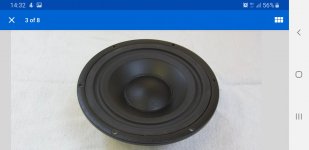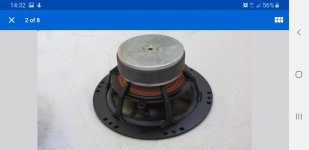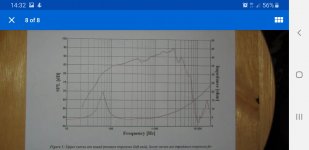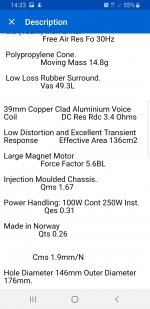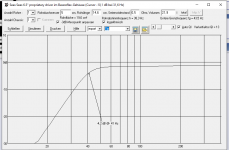Won these cheap on Ebay. They are a proprietary design made by Seas for a speaker manufacturer that went bust unfortunately. I have no idea who.
They are very affordable at £26 per pair so I decided to take a punt.
Do the specs lend themselves to anything obvious?
30Hz Fs could be handy for the lower octaves. Maybe cross to a 3" fullrange that I seem to like at the moment.?

They are very affordable at £26 per pair so I decided to take a punt.
Do the specs lend themselves to anything obvious?
30Hz Fs could be handy for the lower octaves. Maybe cross to a 3" fullrange that I seem to like at the moment.?
Attachments
It looks like Falcon Acoustics used to stock them. Report on stick performance here.
https://www.falconacoustics.co.uk/downloads/Seas/h1398_datasheet.pdf
The page has gone but a search suggests they were £19.95 plus vat each at one point.
Qts seems quite low - there are some ideas on this thread (reply #5) which suggests horn loaded.
Low Qts woofer
https://www.falconacoustics.co.uk/downloads/Seas/h1398_datasheet.pdf
The page has gone but a search suggests they were £19.95 plus vat each at one point.
Qts seems quite low - there are some ideas on this thread (reply #5) which suggests horn loaded.
Low Qts woofer
Well specs are specs and any driver is going to have to be integrated into the system by the crossover. This driver's Qts indicates it should be used in a ported enclosure. Using a computer modeling program would give you a better idea of what designs would make optimum use of this driver.
Thanks for all the replies.
I did Google the code but came up blank for some reason. Must try harder!
I have modelled in Winisd in a modest ported enclosure. I guess I was more asking towards the integration into the HF driver.
Quick general question.....what does the Fs tell us exactly?
An Fs of 30Hz doesn't necessarily mean it will produce that frequency? I see the impedance peak is at Fs. Should one avoid any port tuning near there.....or conversely....should one aim for there?
I am.new to this obviously...sorry for the beginners questions.
I did Google the code but came up blank for some reason. Must try harder!
I have modelled in Winisd in a modest ported enclosure. I guess I was more asking towards the integration into the HF driver.
Quick general question.....what does the Fs tell us exactly?
An Fs of 30Hz doesn't necessarily mean it will produce that frequency? I see the impedance peak is at Fs. Should one avoid any port tuning near there.....or conversely....should one aim for there?
I am.new to this obviously...sorry for the beginners questions.
Fs is the free air resonance of the driver, that's with no enclosure. For starters: Put the available data into a simulation program of your choice and see what happens. The understanding might follow later on. 🙂
Looks very much like this coax driver, sans tweeter:
SEAS H1353-08/06 T18REX/XFC - 7" Coaxial
Wow, a classic RE with cone Whizard replaced by a textile dome, that interesting ...... but I would not call it coaxial ....
But it *is* a coaxial, there is a 26mm voice coil driver at the back of that magnet, complete with phase plug, short horn built inside the pole piece, and the main cone acting as a horn extension.Wow, a classic RE with cone Whizard replaced by a textile dome, that interesting ...... but I would not call it coaxial ....
No whizzer anywhere and the textile dome is just a dustcap.
Just look at the response and impedance curves, the blue ones belong to the HF driver.
EDIT: sorry, I am referring to the speaker datasheet linked in post #2 .
Yes, the first one looks like the woofer component, but was never intended as a full range driver, never had a whizzer cone anyway, the dustcap is just that.
Last edited:
Thanks for the additional info and to ICG for modelling.
The driver in the link to the build maybe similar but doesn't have the same surround, mine have a reverse surround.
I had a reply from Seas to say they were for a company called Revolution Audio in Asia but are contractually bound to withhold the specs.
The driver in the link to the build maybe similar but doesn't have the same surround, mine have a reverse surround.
I had a reply from Seas to say they were for a company called Revolution Audio in Asia but are contractually bound to withhold the specs.
Well, I guess you'll have to measure them!
Let me know if you need a hand.
Looking at that 2.5kHz peak, I'd want to cross over at or below 1.5kHz-ish. A small compression driver or full range driver would work well here.
Chris
Let me know if you need a hand.
Looking at that 2.5kHz peak, I'd want to cross over at or below 1.5kHz-ish. A small compression driver or full range driver would work well here.
Chris
Hey Chris....thanks for the offer. Would be interesting.
The 8" LR22 were just too big for my room...well too big for the wife! These were cheap enough to have a play with although I had noticed the response isn't exactly flat and so maybe not the easiest things to integrate with an HF driver.... not for a beginner maybe atleast.!
The 8" LR22 were just too big for my room...well too big for the wife! These were cheap enough to have a play with although I had noticed the response isn't exactly flat and so maybe not the easiest things to integrate with an HF driver.... not for a beginner maybe atleast.!
- Status
- Not open for further replies.
- Home
- Loudspeakers
- Multi-Way
- Uses for these Seas 6.5" proprietary drivers
